.jpg)
Art in Spring Lane Building
Discover a range of artworks exploring themes such as immigration, injustice and human rights.
Complete list of artworks
- Amazonia Past, Present and Future by James McKay
- We are here, because you were there: Afghan interpreters in the UK, by Andy Barnham and Sara de Jong
- The Witness by Nderva Mutua
- Backstabbed by Nderva Mutua
- Insecure; Secure, by Deena Mohamed
- Pneuma-city by Andrew Esiebo
- A Blanket for Human Rights Defenders by Rosa Borrás
- The Price of Choices by Juliana Mensah
- The Tiny Encyclopedia by Ana Zbona, Tom Novak and Enej Gala
Amazonia Past, Present and Future
The photographs of original acrylic paintings were created by James McKay.
With few climate projections looking past 2100 CE (Common Era), longer-term projections aren’t being factored into environmental decision-making today. In a recent article in Global Change Biology, Christopher Lyon, Lindsay Stringer, and Robert Marchant (Environment and Geography) began to explore this question.
From this research, artist James McKay offered artistic interpretations showing the past, present and future views of a selected number of case studies around the world, in this case Amazonia. Each column of images shows the same Amazonian landscape in three different eras, from the top (the past), to the bottom (the future).
The top row shows the traditional Indigenous lifestyle (1500 CE), the middle row presents three present-day landscapes affected by intensive agriculture and modern infrastructure. The bottom row of images considers what Amazonia could be like in the year 2500 CE, it shows a barren landscape, degraded infrastructure, and minimal human activity. If we fail to halt climate change, the next 500 years will change the Earth in ways that challenge our ability to survive.
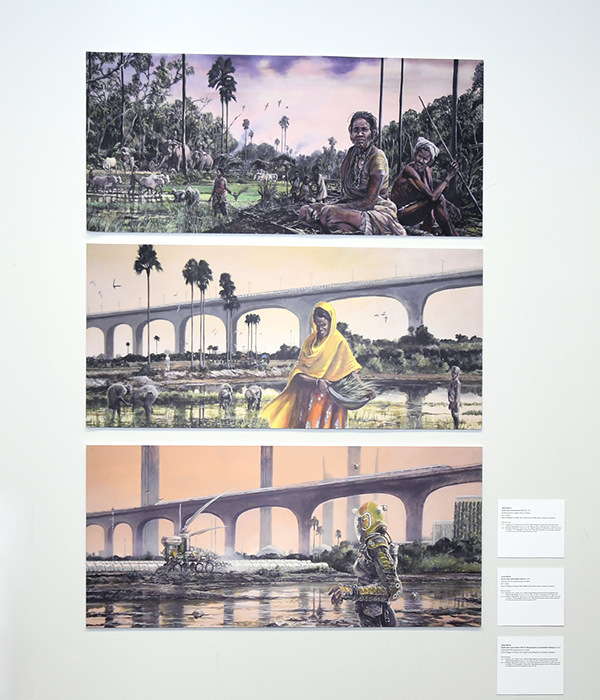
We are here, because you were there: Afghan interpreters in the UK
This photographic series was created by Andy Barnham and Sara de Jong.
For this project, Sara de Jong (Politics) teamed up with photographer Andy Barnham. Sara researches the claims to protection and rights by Afghan interpreters employed by western armies. She is also the co-founder of the charity Sulha Alliance. Andy brought his lived experience as an Afghanistan veteran and as the child of a refugee.
Between December 2021 and March 2022, they travelled to England, Scotland and Wales to visit 14 recently arrived Afghan interpreters in hotels, temporary accommodation and their new homes. The project’s title We are here, because you were there references the long lineage of postcolonial migrants to the UK and captures the relationship between migration, (neo-)imperialism, violence and exploitation.
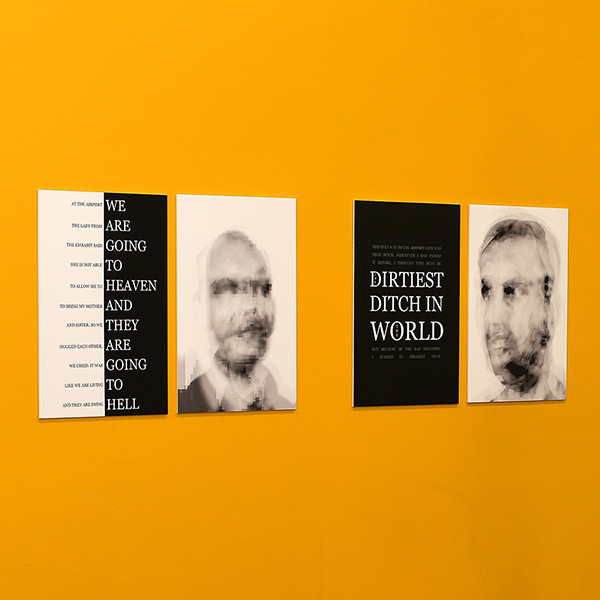
The Witness (Security of Defenders Project)
Ndereva Mutua created this oil on canvas painting.
In 2017, artists from around the world were invited to produce creative responses to research findings from projects at the Centre for Applied Human Rights on the security and protection of human rights defenders at risk. The responses included poetry, songs and music, short films, animation, drawings, paintings and murals.
Ndereva Mutua is an artist from Nairobi’s Mathare area. His art is mostly used to inspire social change. His painting The Witness depicts a human rights defender witnessing his friend being killed while he anticipates his own death. Mutua Ndereva is a dedicated member of the Social Justice Centers Movement, a coalition of over 60 grassroots justice centres that aims to strengthen democracy, protect freedoms, and fight for social justice.
As part of the Arts and Sports for Justice Committee, Mutua utilises art and sport as powerful tools for advocacy. He teaches aspiring graffiti and fine artists from various informal settlements and engages in live graffiti setups that raise awareness about the violations experienced by these communities.
Mutua uses art as a means of expression, empowering individuals to share their stories and to advocate for change. Mutua and his students represent the struggles faced by these communities through vibrant graffiti, amplifying their voices and demanding attention from wider society.
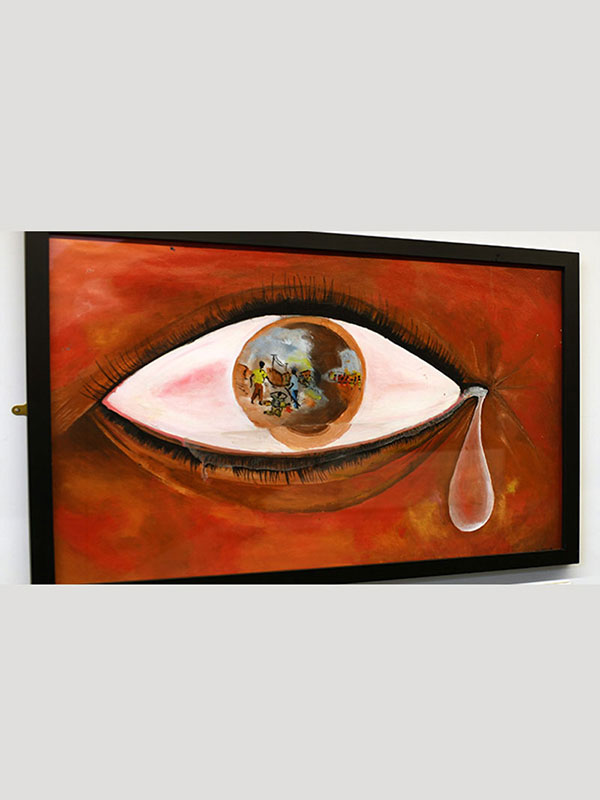
Backstabbed (Security of Defenders project)
This graphite pencil drawing was created by Nderva Mutua.
In 2017, artists from around the world were invited to produce creative responses to research findings from projects at the Centre for Applied Human Rights on the security and protection of human rights defenders at risk. The responses included poetry, songs and music, short films, animation, drawings, paintings and murals.
His painting Backstabbed tells the story of a woman human rights defender whose son was killed to stop her fighting for justice. Mutua Ndereva is a dedicated member of the Social Justice Centers Movement, a coalition of over 60 grassroots justice centres that aims to strengthen democracy, protect freedoms, and fight for social justice.
As part of the Arts and Sports for Justice Committee, Mutua utilises art and sport as powerful tools for advocacy. He teaches aspiring graffiti and fine artists from various informal settlements and engages in live graffiti setups that raise awareness about the violations experienced by these communities.
Mutua uses art as a means of expression, empowering individuals to share their stories and to advocate for change. Mutua and his students represent the struggles faced by these communities through vibrant graffiti, amplifying their voices and demanding attention from wider society.
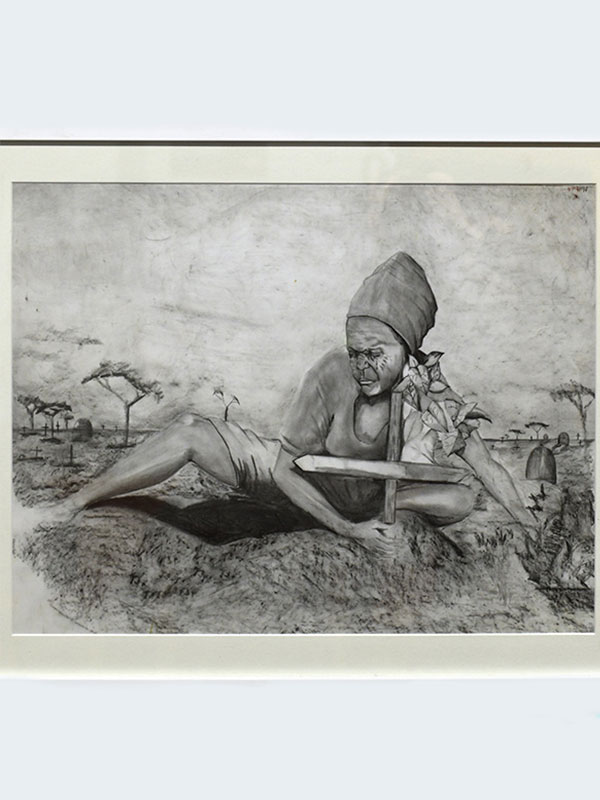
Insecure; Secure
This graphic cartoon was made by Deena Mohamed.
Artists from around the world were invited to produce creative responses to the research findings from projects on the Security and Protection of Human Rights Defenders at Risk, led by Alice Nah (then at the Centre for Applied Human Rights). The study asked ‘What factors make you feel insecure?’ and ‘What factors make you feel secure?’ Deena Mohamed, who is based in Egypt, illustrated some of the responses to these questions from defenders at risk in Egypt.
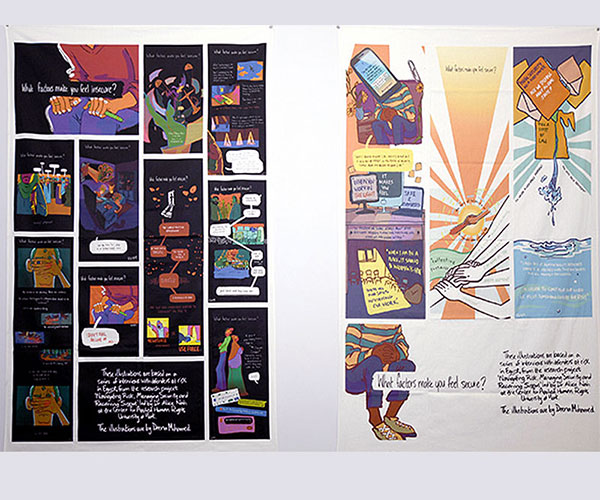
Pneuma-city
Andrew Esiebo created this photographic series.
These photographs, taken by Andrew Esiebo, are for a project titled Pneuma-city: Frictional infrastructure, road ecologies and valorisation of end-of-life tyres (ELTs) towards more sustainable urban economies in Lagos, Nigeria. This research brought together researchers at York, (Gareth Millington, Sociology), University of Kent, University of Toronto and University of Lagos.
Combining insights from social science and engineering, Pneuma-city explores the impact of used tyres on road ecologies and streetscapes, while also examining the urban economies of tyre repair and the repurposing and recycling of used tyres.
Andrew Esiebo’s photographs explore each of these themes while demonstrating how a renewed understanding of the city can be created through the prism of used tyres. The project is concerned with the social worlds, livelihoods, knowledge and occupational cultures/vulnerabilities of informal roadside workers (such as vulcanisers) and the ways in which they interact with the everyday (material and social) flows of the megacity.
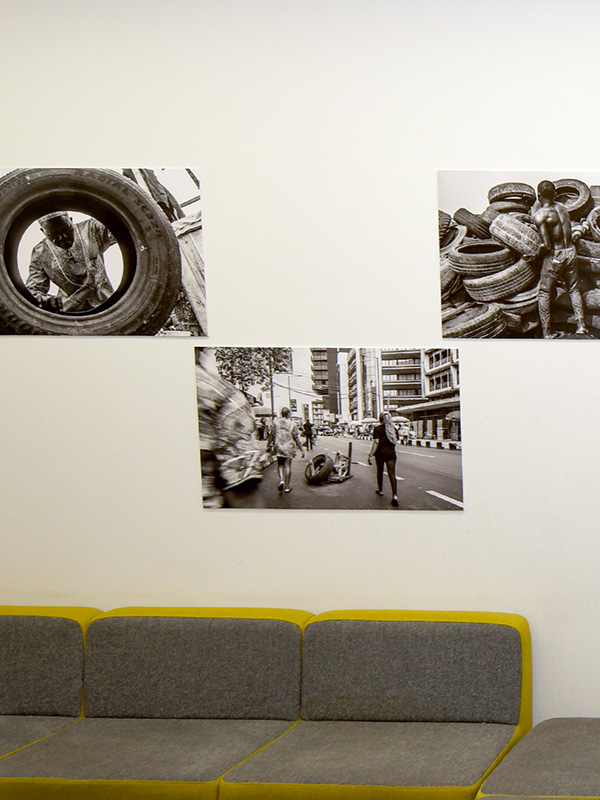
A Blanket for Human Rights Defenders
This textile artwork was created by Rosa Borrás.
Rosa Borrás’s quilt was made from the shirts worn by protesters on marches in Mexico. The embroidered quotes are the words of Mexican human rights defenders taken from the poem 'Greater than Love' by Juliana Mensah (English and Related Literature).
In the words of Rosa Borrás: “A cobija is a blanket, and cobijar means to give shelter, to offer refuge, to protect someone. It’s a verb, an action. That’s the reason I like to make blankets from fabric scraps: making a blanket has a very symbolic meaning to me, and that’s why I decided to make one as a response to the project Navigating Risk, Managing Security, and Receiving Support led by Alice Nah. It also has a double meaning: human rights defenders protect us, but we also need to protect, shelter and take care of them. We need to show the work they do as well as the risks they face and the way they deal with them.”
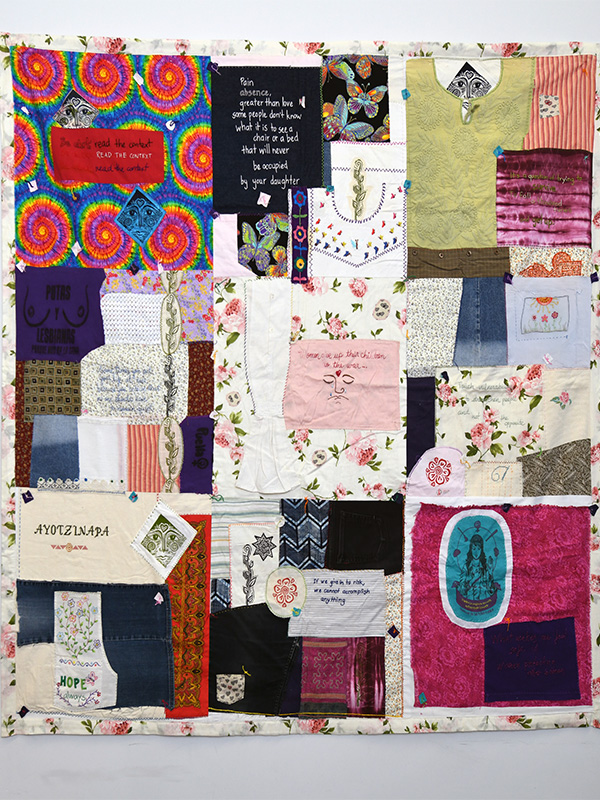
The Price of Choices (Security of Defenders project)
This poem was created by Juliana Mensah.
The poem was composed by Juliana Mensah (English and Related Literature), from the interview transcript of a woman human rights defender from Egypt working on civil and political rights. From the research project Navigating Risk, Managing Security, and Receiving Support at the Centre for Applied Human Rights, which focused on the experiences of human rights defenders at risk in Colombia, Mexico, Egypt, Kenya, and Indonesia.
The Tiny Encyclopedia of Authoritarian Flora
This illustration was created by Ana Zbona, Tom Novak and Enej Gala.
The Tiny Encyclopedia of Authoritarian Flora is part of the Arctivism project (Centre for Applied Human Rights). Using metaphors to present how leadership grew more authoritarian during COVID-19, Ana Zbona, Tom Novak and Enej Gala focus on Hungary, Turkey and the USA here, presenting Satan's Orban, Erdoggplant and Trumptato.
They show how authoritarian leaders are like poisonous mushrooms, weeds, smelly onions plants and other difficult and divisive members of the plant kingdom that can take over our gardens and forests, make us sick, and even kill us if we don't see them for what they are and handle them properly.
One of the most powerful means to rein them in is learning what makes them 'grow', phenomena such as the COVID-19 pandemic and the recovery period, for example, provided an ideal growing ground. Using a mixture of visuals and humorous satirical descriptions, each authoritarian leader is presented in his/her own "chapter" in the Tiny Encyclopedia, taking on the character of a pesky plant.
